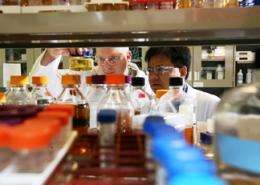Gene discovery potential key to cost-competitive cellulosic ethanol

(PhysOrg.com) -- Scientists at the Oak Ridge National Laboratory are improving strains of microorganisms used to convert cellulosic biomass into ethanol, including a recent modification that could improve the efficiency of the conversion process.
Biofuels researchers and industrials have generated improved mutant microorganisms previously, but authors of a paper in the on-line Proceedings of the National Academy of Sciences identify a key Z. mobilis gene for the first time and show the strain's improved efficiency and its potential use for more cost-effective biofuel production.
"Microbes have been breaking down plant material to access sugars for millennia, so plants have evolved to have very sophisticated cell structures that make accessing these sugars difficult," said Steven Brown, staff microbiologist in the Biosciences Division and one of the inventors of the improved Z. mobilis strain.
Currently, biomass materials like corn stover and switchgrass must undergo a series of pretreatments to loosen the cellular structure enough to extract the sugar cellulose. Brown said these treatments add new challenges because, although they are necessary, they create a range of chemicals known as inhibitors that stall or stop microorganisms like Z. mobilis from performing the fermentation.
"There are two ways to combat recalcitrance, or the difficulty created by the inhibitors," Brown said. "One way is to remove the inhibitors, but this method is very expensive and would not help biofuels become cost-competitive with gasoline. The second way is what we do, which is to develop microorganisms that are more tolerant of the inhibitors."
The non-mutated strain of Z. mobilis, for instance, cannot grow in the presence of one of the predominant inhibitors, acetate. However, when gene nhaA is over-expressed by inserting a slice of DNA containing the gene into the non-mutated strain, the bacterium can withstand acetate in its environment.
Brown and lead author Shihui Yang did not stop with Z. mobilis but looked at related genes in other microorganisms and found that the method translates in different organisms.
"We took this gene and integrated it into a strain of yeast, and the improvements carried over into the yeast," Yang said.
Brown says this method of processing biomass for ethanol has the potential to become a "tool kit" — a combination of mutant genes that reduce the impact of specific inhibitors. The tool kit could expand quickly, too, as scientists now have more advanced DNA sequencing technology available to identify and resequence genes.
"The DNA sequencer we used was unavailable as recently as five years ago, and it has unprecedented sequencing capabilities. It is 4,000 times more powerful than the machine that finished sequencing the human genome almost a decade ago," Brown said.
ORNL microbiologists are currently sequencing other microorganisms used in biofuels production that could also be advantageous if genetically altered to resist different types of inhibitors.
"By looking at the behavioral response to the genetic changes in this bacteria, Zymomonas, we can then look forward to improving other bacteria," Yang said.
Provided by Oak Ridge National Laboratory















